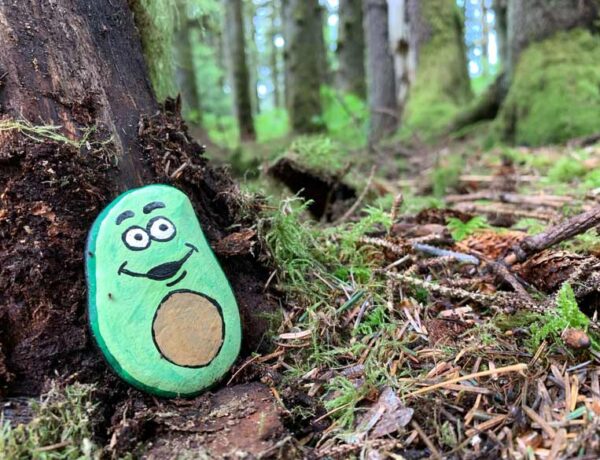What can be better than the smell of cinnamon and a bowl of hot fruit topped with just the right amount of crunch? We’re talkin’ comfort food!
Since rhubarb “forests” are appearing in local gardens, I want to share one of my favorite berry crisp recipes… starting at the top:
Easy All-Purpose Topping
Crumbly, dairy-free, with the right amount of spice and sweetness, this topping is great on cobblers and pies. Plus, it stores well in the fridge or freezer. Double the recipe to have extra on hand. When reading through the list of ingredients, you might notice the absence of butter.
Not by accident.
Five years ago, Marty and I adopted a whole-food, plant-based (WFPB) diet. While it’s not 100 percent, we’ve pretty much eliminated dairy products (cheese, eggs, milk), animal protein, and processed oils—including olive oil (stop me in the grocery store someday, and I’ll explain why).
It took me several years to learn how to shop and cook all over again, but now it’s smooth sailing in the kitchen…
Whether or not you adhere to a WFPB diet, you’ll love this rich and crumbly topping.
My Favorite All-Purpose Topping
1/2 cup brown sugar, firmly packed
1/2 cup unbleached flour
1/2 cup almond or other nut butter
1/2 cup old-fashioned rolled oats
1/4 cup sliced almonds
1/2 tsp salt (optional)
In a medium bowl, combine brown sugar, flour, and salt. Work in almond butter with your fingertips until mixture is crumbly. Mix in rolled oats and almonds. Sprinkle over fruit. Bake as per recipe.
NOTE: For a gluten-free variation, simply replace wheat flour with your flour of choice.
Now let’s get to the yummy, berry crisp recipe. I’ve tweaked it for years… and my favorite combo includes rhubarb.
I think you’ll find this recipe very “forgiving.” You can adjust amounts of rhubarb or apples. And heck, why not get ready for the harvest by cleaning out your freezer with whatever berries you have hidden there!
Rhu-Berry Crisp
2 cups diced rhubarb
2 cup chopped apples
3 cups fresh or frozen berries
3/4 cup sugar
1/4 cup quick tapioca
1 TBL ground cinnamon
In a large bowl, toss together fruit, sugar, tapioca, and cinnamon. Spoon into a 9×13-inch pan (or into two, 8×8-inch pans) and bake at 350-degrees for 45 minutes. (Bake a few potatoes or yams while you’re at it).
Now for a change of direction…
In last week’s column, I offered some ideas to get carrot seeds to germinate — a lesson in patience, for sure. This week, it’s how to get up the gumption to THIN the little seedlings…
[perfectpullquote align=”full” bordertop=”false” cite=”” link=”” color=”” class=”” size=””]Many gardeners can’t bring themselves to thin out carrots… almost to the point of needing therapy.[/perfectpullquote]
Thing is, all plants need space to grow, just like kids require larger shoes as they age. When you start plants in pots, dividing them is usually not a problem: Just separate the seedlings when it’s time to transplant them outdoors.
Plants that you sow directly in the ground, especially root vegetables, are another matter.
Bottom line: If you want a successful crop of carrots, beets, or calendulas, thinning is beautiful…
Why’s that?
Because thinning seedlings helps plants by:
1. Allowing room for unrestricted root growth
2. Reducing competition for water and nutrients
3. Allowing for good air circulation (fewer pest problems)
How to thin seedlings:
>>> Flowers and leafy vegetables such as lettuce and spinach can be thinned by gently pulling the unwanted plants. Seeds that you scattered in rows or patches for a quick crop of cut-and-come-again salad greens, don’t need to be thinned.
>>> On the other hand, carrots, and other root vegetables, including onions and turnips, are more sensitive to thinning because overly disturbing young roots can cause twisted and tangled roots. If you’ve ever tried to transplant carrot seedlings, you often end up with forked carrots, which can be amusing.
Here are some spacing guidelines for thinning:
Beets: 3 to 6 inches
Carrots: 2 to 3 inches
Lettuce: 12 to 18 inches
Onions (bulbing): 3 to 5 inches
Onions (green, spring): 1 to 3 inches
Radishes: 2 to 3 inches
Rutabagas: 6 to 8 inches
Turnips: 2 to 4 inches
Oh, and one more thing, if I may. While thinning seedlings, don’t agonize over every single seedling that you pull. Relax and focus on the task at hand, knowing that it’s all for the best.
Thanks for stopping by.
Peas on Earth!

PS Are you frustrated spending so much time pulling weeds? Or watching your plants wither in a drought? After 35 years of gardening, I have learned one thing for sure: Compost is the answer to all your problems. Want to know how to make compost in 6 short weeks? (now THAT is a tongue-twister!)? Join the waitlist for my next FREE composting webinar. And you might enjoy my Joy of Composting Facebook page. If you’d like to drop me a note, here’s my email address: marion (at) marionowenalaska.com.





No Comments